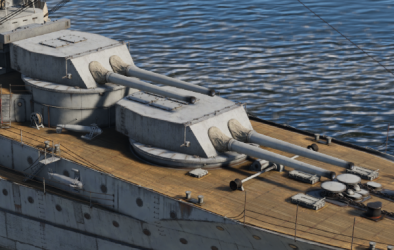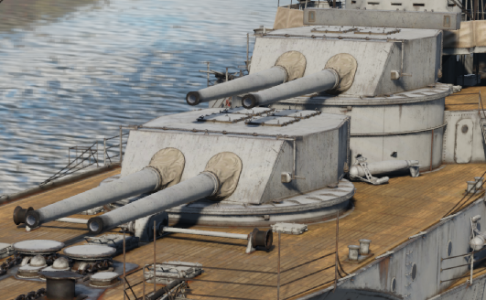12-inch/45 Mk.5 (305 mm)
Contents
Description
Write an introduction to the article in 2-3 small paragraphs. Briefly tell us about the history of the development and combat using the weaponry and also about its features. Compile a list of air, ground, or naval vehicles that feature this weapon system in the game.
Vehicles equipped with this weapon
General info
Tell us about the tactical and technical characteristics of the cannon or machine gun.
Available ammunition
Describe the shells that are available for the weapon and their features and purpose. If it concerns autocannons or machine guns, write about different ammo belts and what is inside (which types of shells).
| Penetration statistics | |||||||
|---|---|---|---|---|---|---|---|
| Ammunition | Type of warhead |
Penetration @ 0° Angle of Attack (mm) | |||||
| 1,000 m | 2,500 m | 5,000 m | 7,500 m | 10,000 m | 15,000 m | ||
| Cl.B HE | HE | 68 | 68 | 68 | 68 | 68 | 68 |
| Mk.7 APCBC | APCBC | 501 | 447 | 371 | 311 | 264 | 204 |
| Shell details | ||||||||||||
|---|---|---|---|---|---|---|---|---|---|---|---|---|
| Ammunition | Type of warhead |
Velocity (m/s) |
Projectile mass (kg) |
Fuse delay (s) |
Fuse sensitivity (mm) |
Explosive mass (TNT equivalent) (kg) |
Ricochet | |||||
| 0% | 50% | 100% | ||||||||||
| Cl.B HE | HE | 823 | 335.65 | 0 | 0.1 | 33.25 | 79° | 80° | 81° | |||
| Mk.7 APCBC | APCBC | 823 | 394.6 | 0.035 | 17 | 11.78 | 48° | 63° | 71° | |||
Comparison with analogues
Give a comparative description of cannons/machine guns that have firepower equal to this weapon.
Usage in battles
Describe the cannon/machine gun in the game - its distinctive features, tactics of usage against notable opponents. Please don't write a "guide" - do not impose a single point of view, but give the reader food for thought.
Pros and cons
Summarise and briefly evaluate the weaponry in terms of its characteristics and combat effectiveness. Mark pros and cons as a list.
Pros:
Cons:
History
The 12-inch/45 Mark 5 begins its story in the late 1890s. While smokeless powder, a revolution in firearms design was invented in 1884, the United States Navy didn't adopt it until the late 1890s after the Spanish American War. The first naval monitor battery to use these types of weapons was the 12 inch/40 calibre which would serve in Marks 3 and 4 on pre-dreadnought battleships of the United States in the early 19th century. The 12-inch/45 Mark 5 was developed as an improvement of this gun constructed at the US Navy Gun Factory in Washington DC with the specifications from the Bureau of Ordnance. The gun was made 5 calibres longer for improved muzzle velocity, range, and penetration power.
The 12"/45 Mark 5 gun entered service in 1906, which was an interesting period for warship development. The guns were first designed and used on the Connecticut-class of pre-dreadnought battleships and the later Mississippi-class. However, 1906 was the year that the ship HMS Dreadnought was launched, with a strictly big gun arrangement that rendered every other battleship obsolete overnight. The big gun arrangement had benefits that the US Navy was not blind to as they had been working on such a design since 1903 before the HMS Dreadnought was ordered by the Royal Navy in 1905. The result ended up becoming the South Carolina-class ships, the USS South Carolina and USS Michigan, which were ordered a month after HMS Dreadnought was launched, but boasted a superior center-fire arrangement for the armament (HMS Dreadnought had a port and starboard turret battery - the only dreadnought to do so). However, in the summer of 1916, the USS Michigan blew out one of her turrets which prompted an investigation into her sister South Carolina. The investigation concluded that the guns suffered from what is known as "copper choke", where the copper deposits from the driving bands on the bore of the rounds narrowed the bores and created a dangerous level of pressure when firing.
The South Carolina-class was soon followed by the Delaware-class ships USS Delaware and USS North Dakota. The United States would go on to produce a final class of dreadnoughts - the Florida-class ships USS Florida and USS Utah - but these would become the last of the ships to be armed with 12"/45 Mark 5 guns. The turn of the century marked a significant arms race among the various powers around the world, which had been intensified by the appearance of HMS Dreadnought in 1906 and escalated tension around the globe before World War I. At the end of the war, the victorious powers of the Entente banded together and signed the Washington Naval Treaty in 1922 which, among other stipulations, put a ten year hiatus or "holiday" as it was called on construction capital ships such as battleships from the five signatories. Then, in 1930, the London Naval Treaty was signed which required the Florida-class to remove their 12"/45 Mark 5s where they were transferred to the United States Army to serve as coastal defense batteries.
The most surprising element of the 12-inch/45 Mark 5's history is despite serving in World War I as part of the US Navy, it was only firing in anger in Greek service. The Mississippi-class ships USS Mississippi and USS Idaho were purchased by the Royal Hellenic Navy in 1914 as an expedient measure to keep up in the naval arms race against the Ottoman Empire. These ships were designated the Kilkis and Lemnos respectively after battles in the Balkan Wars and saw action in the Allied Intervention into the Russian Civil War shortly after the World War I, and the Greco-Turkish War. To guard the Port of Athens, the guns from the Lemnos were removed and placed as coastal defense batteries on the island of Aegina.
Media
- Images
See also
Links to the articles on the War Thunder Wiki that you think will be useful for the reader, for example:
- reference to the article about the variant of the cannon/machine gun;
- references to approximate analogues by other nations and research trees.
External links
| USA naval cannons | |
|---|---|
| 20 mm | 20 mm/70 Oerlikon Mk.II · 20 mm/70 Oerlikon Mark V · 20 mm/70 Oerlikon Mark 24 |
| 25 mm | 25 mm/87 Mk.38 |
| 28 mm | 1.1 inch/75 Mk.1 |
| 37 mm | AN-M4 |
| 40 mm | Bofors L/60 Mark 1 · Bofors L/60 Mark 2 · Bofors L/60 Mark 3 |
| 76 mm | 3 inch/23 Mk.4 · 3-inch/50 Mk.10 · 3-inch/70 Mk.37 · 3-inch Mark 10 · 3 inch Mk.33 · 3-inch Mk.34 |
| 102 mm | 4 inch/50 Mk.9 |
| 127 mm | 5 inch/25 Mk.11 · 5 inch/25 Mk.13 AA · 5 inch/38 Mk.12 · 5-inch/50 Mk.5 · 5 inch/51 Mk.7 · 127 mm/54 Mark 18 |
| 152 mm | 6 inch/47 Mk.16 · 6 inch/47 DP Mk.16 · 6 inch/53 Mk.12 · M81 |
| 203 mm | 8 inch/55 Mark 9 · 8 inch/55 Mark 12 · 8 inch/55 Mark 14 · 8 inch/55 Mark 16 |
| 305 mm | 12-inch/45 Mk.5 · 12 inch/50 Mk.7 · 12 inch/50 Mk.8 |
| 356 mm | 14 inch/45 Mk.8 · 14 inch/45 Mk.12 · 14 inch/50 Mk.11 |





